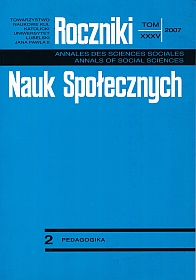Jana Pawła II dorobek zamknięty, dzieło otwarte
Abstrakt
The author begins with a question: who was John Paul II? First he makes a review of various terms used to describe the Pope-Pole. They are found in his many biographies, studies, albums, learned journals, press publications, radio and television broadcasts, and characterisation delivered at learned symposiums in Poland. The author closes this review with a statement that the personality and activity of John Paul II transcends the unambiguous terms used by contemporary journalists, politicians, biographers, and historians. He cannot be enclosed in one field of meaning, or even reduced to several terms.
John Paul II spoke on the formation of teachers and educators, the necessity to prepare them for their job from many points of view and to equip them with educational and didactic skills. He spoke about the serious and subtle question of their vocation and even their apostleship, the necessity to fulfil essential tasks and the need to co-operate with their pupils' parents. These sentences, often quoted in the press, suffice to define the Pope as a good pedagogue, educator, and teacher both in theory and practice.
Starting from the personalistic vision of man, supplemented by the axiological, normative, social and cultural, and religious approaches, John Paul II arrives the overall vision of Christian pedagogy. According to him, education is a continual process that encompasses the formation of personality and serves to build the civilisation of life, truth, and love. That process leads to a full mental development and to engagement in everyday matters. It takes places in various milieus: in the family, social groups, the nation, the state, and the Church. The figure of John Paul II can be seen here as: a teacher, theorist of education, visionary who shows the Church's stance on education, a pedagogue well-aware of the didactic methods and means by which to reach the listener, an author of the educational programme for a definite group of people, for families, and the whole nations.
In his addresses, John Paul II presented many accurate social and pedagogical diagnoses. This his figure appears to be a foreseeing pedagogue, caring educator, lover of people, the one who sees their errors and weaknesses, but at the same time encourages them to positive actions, to demand of themselves, and to reach the long-term goals.
The exceptional character of his life consists not only in the diverse form of his teaching. He also set on apostolic journeys and was an exemplary figure when he showed us how to suffer illnesses, and how he coped with the assault on his life. Journalists and biographers admired him for his words about God, man, societies, history, and the contemporary times. He regularly met with the suffering and the sick, talked with them, consoled brought, and administered the Holy Communion to them. Following the Pope's order, a “Gift of Mary” hostel for the poor was built in the Vatican. The Pope showed pedagogical and educational values.
His addresses on pedagogical and social issues often encouraged people to action and released creative opportunities. He did not only appeal, instruct, and summon, but also provided funds for those societies who had suffered disasters, for the poor in Latin America, for the countries in Sahara struggling against drought.
The teaching of John Paul II was the key element of his pontificate and an important chain in governing the Church.
While responding to the questions whether John Paul II's teaching was accepted, the author points to various manifestations of how people approved of his pedagogy. These are, among other things, letters written to him, gratitude for counsels and guidelines, many books and albums with dedications, precious arts of work, artistic and useful products, liturgical garments and vessels, medals and numismatists. A large part of them is stored in Rome, in the Centre of the Documentation of John Paul II's Pontificate at via Cassia 1200, in the Vatican Museum and Library, and in other museum collections.
All these gifts may be treated as a token of social approval and acceptance of his teaching, recognition of his views, attitude, or addresses. They were also given to show gratitude that he had visited a particular place in his Homeland, or hosted a delegation during the audiences.
John Paul II influenced the masses of people and small groups, families, and the lonely. He encouraged them to creativity, to various activities, to show mutual help, and to kindness. Thereby he encouraged people to seek a more satisfactory model of life, in which activity, creativity, and solidarity would be basic elements.
Copyright (c) 2007 Roczniki Nauk Społecznych

Utwór dostępny jest na licencji Creative Commons Uznanie autorstwa – Użycie niekomercyjne – Bez utworów zależnych 4.0 Międzynarodowe.


